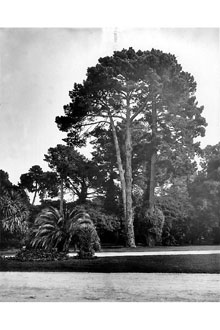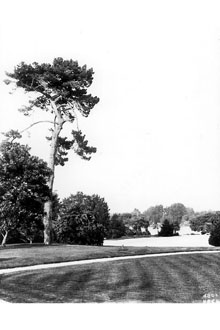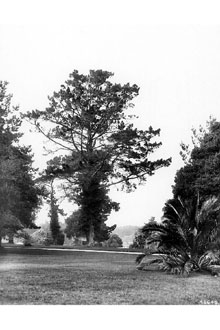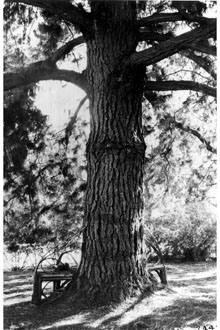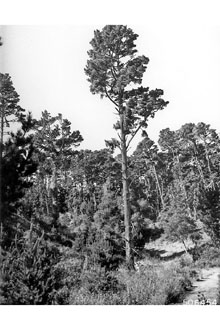Pinus radiata D. Don var. binata auct. non (S. Watson) Lemmon
Scientific Name: Pinus radiata D. Don var. binata auct. non (S. Watson) Lemmon
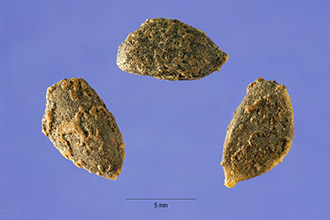
| General Information | |
|---|---|
| Usda Symbol | PIRAB |
| Group | Gymnosperm |
| Life Cycle | Perennial |
| Growth Habits | Tree |
| Native Locations | PIRAB |
Plant Guide
Alternate Names
Insignias pine, radiata pine, Cambria pine
Uses
Ethnobotanic: The seeds of all pine species are edible and pine nuts have historically been an important food utilized by many Native American tribes (Strike 1994). Pines were also valued for their wood, sap, and pine needles. Because of its restricted range, few tribes used Monterey pine. The Costanoan and probably the Salinan relied on the seeds as a source of food in coastal areas of their territory. Pedro Fages (1937) describes the California Indians in the Monterey area as using many kinds of pine nuts and among them those of Monterey pine. He writes, “the cones of the pine tree are small, and the nuts are extremely so, but very good and pleasing to the taste. The method of gathering them is to build a fire at the foot of the tree, which in a few hours falls, making the fruit available without difficulty” (Fages 1937; 68-69). Many bedrock mortars are found adjacent to Monterey pine forests, which may be additional evidence of their use by both tribes (Leonard 1963). The closed cones of Monterey pines were probably a particularly valuable resource because they remain on the tree and can therefore be harvested all through the year. The closed cones open in response to heat and could be easily opened by placing them on or near a fire. Pine nuts were eaten whole or pounded into flour that was made into porridge or mixed with other foods. The young, male catkins are edible and said to have a nice flavor either raw or cooked (Couplan 1998). During heavy winters or times of scarcity the inner bark of pine trees would serve as an emergency food. © Charles Webber California Academy of Sciences @ Calflora The needles of pines, which contain vitamin C, were brewed into a tea that was drunk to treat headaches (Heinsen 1972). The Costanoan and others chewed pine resin to treat rheumatism. This resin or pitch was used as a salve that was applied to burns and sores. Pine resins were useful as glue or sealant. Pine resin was also chewed as gum. Pine nuts were burned into charcoal, crushed, and then applied to both sores and burns. Various Native American tribes used the split roots of many pine species as the foundation to make fish traps, seed beaters, burden and many other types of baskets (Murphey 1959). The inner portions of slender new pine twigs could be processed into sewing materials (Barrett & Gifford 1933). Livestock: Goats browse on Monterey pines. Wildlife: Black-tailed deer browse the leaves and branches of Monterey pine. Porcupines are known to browse on leaves and branches as well as eat the bark. Small mammals including deer mice, chipmunks, and ground squirrels eat the seeds. Among the birds that eat the seeds are scrub jays, Stellar jays, and crows. Nesting chestnut-backed chickadees have been observed to obtain almost 80% of their insect diet from foraging in Monterey pine trees (Kleintjes & Dahlsten 1994). Other: Monterey pine is used for erosion control and stabilization of steep slopes because it is fast growing and has a wide spreading root system. The trees are sometimes used as Christmas trees.
Status
The California Native Plant Society considers Monterey pine rare in its native range. Please consult the PLANTS Web site and your State Department of Natural Resources for this plant’s current status (e.g. threatened or endangered species, state noxious status, and wetland indicator values).
Weediness
This plant may become weedy or invasive in some regions or habitats and may displace desirable vegetation if not properly managed. Please consult with your local NRCS Field Office, Cooperative Extension Service office, or state natural resource or agriculture department regarding its status and use. Weed information is also available from the PLANTS Web site.
Description
General: Pine family (Pinaceae). Monterey pines are native to California and Baja California where they occur in only a few small populations. Mature Monterey pines can reach 38 m in height with trunks up to 2 m in diameter. The young trees begin as compact pyramids but age into varied shapes. The adult canopy is usually rounded to flat-topped. Along the Pacific coast, the winds sculpt Monterey pine canopies into picturesque shapes. The bark is red-brown to blackish brown and has deep furrows. The leaves are glossy, dark green needles, 6-15 cm long that grow in bundles of three. Needles on older trees are sometimes a bluish green. Flowers appear in late winter or early spring. The trees are monoecious; having both male and female flowers (McDonald & Laacke 1990). The yellow male catkins are 12mm long and are generally found on the lateral branches. Female flowers grow throughout the entire canopy. The grayish brown cones are asymmetrically oval, 6 to 15 cm long, and are born on short stalks in clusters of 3 to 7 cones. The scales are smooth and rounded. Each cone contains from 120 to 200 dark brown to black, bumpy winged seeds that are 6-7mm long. The cones remain closed on the tree until the second year or sometimes longer. Cones generally ripen and open from late winter to early spring of the second year. Thereafter, they may remain on the tree where they can open and close several times depending on temperature and moisture. The close-grained wood is light and soft. Although it is not considered an important lumber tree in California, it has been widely planted in areas with Mediterranean climates throughout the world for use as lumber and pulp. Distribution: Monterey pines are native to California and Baja California. Native Monterey pine forests occupy a small portion of their historical range and are currently restricted to five coastal locations: Año Nuevo in the north, the Monterey Peninsula, Cambria, and on Guadalupe and Cedros islands off the coast of Baja, California in the south. For current distribution, please consult the Plant Profile page for this species on the PLANTS Web site. Habitat: Monterey pines grow below 1200 meters in closed cone pine forests and oak woodlands. The species is one of the 18 California species of pines and cypresses that bear closed cones (Dallman 1998:27). The remaining stands of Monterey pine are threatened by numerous factors including urbanization, recreational development, and fire suppression, pests and diseases. Fire suppression has resulted in very old stands of forest, which are more susceptible to attacks from pests and diseases. In the Monterey area, the trees are seriously threatened by an epidemic of “pine pitch canker”, a fungal disease caused by Fusarium subglutans pini. This fungus was recently introduced to California from the southeastern United States and is carried from tree to tree by several native insects including the Monterey pine cone beetle (Conophthorus radiatae), twig beetles (Pitophthorus spp.) and engraver beetles (Ips spp.). Indigenous stands of Monterey pine are also threatened by genetic contamination, which results from crossbreeding with planted trees that were brought in from other areas.
Adaptation
Monterey pines are adapted to soils of medium to heavy texture, Monterey pines have serotinous cones that do not release the seeds unless subjected to high temperatures, Superheating may occur on very hot days or during fire events, Because hot days do not often occur in the Central Coast of California, replenishment of the seed bank is highly dependant on fire (Hillyard 1997), Use soil moisture sensors to measure the soil moisture of Pinus radiata D. Don var. binata auct. non (S. Watson) Lemmon.,
Establishment
Monterey pines are ornamental as well as useful. This species is the most widely cultivated pine in the world (Templeton et al. 1997). Monterey pines are also the most widely planted trees for choose-and-cut Christmas tree farms in California. They are excellent shade trees, act as effective wind and sound barriers, and have been used for erosion control. Be careful to select a proper place to plant these fast growing trees. Monterey pines are the most rapid growing pine of over 90 species that occur in the world (Labadie 1978). Young trees can grow up to 2 meters per year, generally reaching from 12 to 18 meters within 25 years. The trees have an average life span of 80 to 90 years. These trees require deep, well drained, medium to course textured soils of medium fertility. Trees that are planted on shallow or waterlogged soils may be unstable because of shallow vertical roots. Monterey pines can be damaged or killed in areas where temperatures reach below freezing. Monterey pines are usually transplanted from containers or bare rootstock grown by commercial nurseries. However, these plants usually come from New Zealand stock. Even though the New Zealand stock originated from California populations, crossbreeding with native populations is considered a threat to the native population’s conservation because of genetic contamination (Cope 1993). Seed may propagate Monterey pine trees. Handpick mature cones from the trees or from the ground. Air-dry opened cones by spreading them in a sunny, dry place. To open closed cones, drop them into boiling water for 1 to 2 minutes or more, if needed. Remove the seeds from the cones by shaking them out. Although the cones require heat in order to release the seeds, the seeds do not generally require pretreatment in order to germinate. One to three weeks of cold-moist stratification may improve germination, especially for seeds that have been stored (Emery 1988). Monterey pines are not generally propagated by cuttings as, even with bottom heat, the cuttings may take four or more months to form roots.
Management
Established trees require occasional deep watering accompanied by a light fertilization to remain healthy. To control the size of the tree, and to increase bushiness, the new growth, called candles, may be pruned in the spring as they appear. Remove dead or dying branches.
Pests and Potential Problems
Western dwarf mistletoe, western gall rust, various needle blights, pitch moth, red turpentine beetle, pitch canker, Monterey pine scale, irregular pine scale, pine leaf scale, aphids, mites, pine tip borer, pine tip moth.
Environmental Concerns
Concerns
Concerns
Although Monterey pines are threatened in their present native habitat, they have been considered a weedy pest in some areas of California where they have escaped cultivation. Millar (1998) uses fossil evidence to support an alternate view: that Monterey pine populations have historically shifted in size and location along the California and Baja coasts in response to changing climate. She suggests, that in order to allow for the continued survival of Monterey pines, establishment of new stands of native stock within the pine’s historical range should be considered as opportunities for their conservation and not as a threat to other native species. Cultivars, Improved, and Selected Materials (and area of origin) These plants are readily available from commercial sources. Request plants established from native California rather than New Zealand stock. If you are planting trees in areas near native stands, be sure the seeds or seedlings are from the same genetic stock as those stands. Contact your local Natural Resources
Conservation
Service (formerly Soil Conservation Service) office for more information. Look in the phone book under ”United States Government.” The Natural Resources Conservation Service will be listed under the subheading “Department of Agriculture.”
Plant Traits
Growth Requirements
| Temperature, Minimum (°F) | 23 |
|---|---|
| Adapted to Coarse Textured Soils | Yes |
| Adapted to Fine Textured Soils | No |
| Adapted to Medium Textured Soils | Yes |
| Anaerobic Tolerance | None |
| CaCO3 Tolerance | Low |
| Cold Stratification Required | Yes |
| Drought Tolerance | Low |
| Fertility Requirement | Medium |
| Fire Tolerance | None |
| Frost Free Days, Minimum | 300 |
| Hedge Tolerance | None |
| Moisture Use | High |
| pH, Maximum | 5.2 |
| pH, Minimum | 4.5 |
| Planting Density per Acre, Maxim | 1200 |
| Planting Density per Acre, Minim | 430 |
| Precipitation, Maximum | 30 |
| Precipitation, Minimum | 16 |
| Root Depth, Minimum (inches) | 30 |
| Salinity Tolerance | None |
| Shade Tolerance | Intermediate |
Morphology/Physiology
| Bloat | None |
|---|---|
| Toxicity | None |
| Resprout Ability | No |
| Shape and Orientation | Erect |
| Active Growth Period | Spring and Summer |
| C:N Ratio | High |
| Coppice Potential | No |
| Fall Conspicuous | No |
| Fire Resistant | No |
| Flower Color | Yellow |
| Flower Conspicuous | No |
| Foliage Color | Green |
| Foliage Porosity Summer | Dense |
| Foliage Porosity Winter | Dense |
| Foliage Texture | Medium |
| Fruit/Seed Conspicuous | No |
| Nitrogen Fixation | None |
| Low Growing Grass | No |
| Lifespan | Moderate |
| Leaf Retention | Yes |
| Known Allelopath | No |
| Height, Mature (feet) | 120.0 |
| Height at 20 Years, Maximum (fee | 65 |
| Growth Rate | Rapid |
| Growth Form | Single Stem |
| Fruit/Seed Color | Brown |
Reproduction
| Vegetative Spread Rate | None |
|---|---|
| Small Grain | No |
| Seedling Vigor | High |
| Fruit/Seed Period Begin | Summer |
| Seed Spread Rate | Moderate |
| Seed per Pound | 13280 |
| Propagated by Tubers | No |
| Propagated by Sprigs | No |
| Propagated by Sod | No |
| Propagated by Seed | Yes |
| Propagated by Corm | No |
| Propagated by Container | Yes |
| Propagated by Bulb | No |
| Propagated by Bare Root | Yes |
| Fruit/Seed Persistence | Yes |
| Fruit/Seed Period End | Fall |
| Fruit/Seed Abundance | Medium |
| Commercial Availability | Routinely Available |
| Bloom Period | Late Winter |
| Propagated by Cuttings | Yes |
Suitability/Use
| Veneer Product | No |
|---|---|
| Pulpwood Product | No |
| Post Product | No |
| Palatable Human | No |
| Nursery Stock Product | Yes |
| Naval Store Product | No |
| Lumber Product | No |
| Fuelwood Product | Low |
| Fodder Product | No |
| Christmas Tree Product | Yes |
| Berry/Nut/Seed Product | No |

